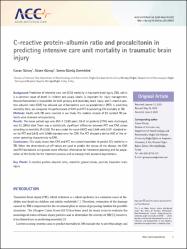| dc.contributor.author | Gürsoy, Canan | |
| dc.contributor.author | Gürsoy, Güven | |
| dc.contributor.author | Gümüş Demirbilek, Semra | |
| dc.date.accessioned | 2022-08-25T06:16:07Z | |
| dc.date.available | 2022-08-25T06:16:07Z | |
| dc.date.issued | 2022 | en_US |
| dc.identifier.citation | Gürsoy C, Gürsoy G, Demirbilek SG. C-reactive protein-albumin ratio and procalcitonin in predicting intensive care unit mortality in traumatic brain injury. Acute Crit Care. 2022 Aug 5. doi: 10.4266/acc.2022.00052. Epub ahead of print. PMID: 35977896. | en_US |
| dc.identifier.issn | 2586-6060 | |
| dc.identifier.uri | https://doi.org/10.4266/acc.2022.00052 | |
| dc.identifier.uri | https://hdl.handle.net/20.500.12809/10234 | |
| dc.description.abstract | Background: Prediction of intensive care unit (ICU) mortality in traumatic brain injury (TBI), which is a common cause of death in children and young adults, is important for injury management. Neuroinflammation is responsible for both primary and secondary brain injury, and C-reactive protein-albumin ratio (CAR) has allowed use of biomarkers such as procalcitonin (PCT) in predicting mortality. Here, we compared the performance of CAR and PCT in predicting ICU mortality in TBI.
Methods: Adults with TBI were enrolled in our study. The medical records of 82 isolated TBI patients were reviewed retrospectively.
Results: The mean patient age was 49.0 ± 22.69 years; 59 of all patients (72%) were discharged, and 23 (28%) died. There was a statistically significant difference between PCT and CAR values according to mortality (P<0.05). The area under the curve (AUC) was 0.646 with 0.071 standard error for PCT and 0.642 with 0.066 standard error for CAR. The PCT showed a similar AUC of the receiver operating characteristic to CAR.
Conclusion: This study shows that CAR and PCT are usable biomarkers to predict ICU mortality in TBI. When the determined cut-off values are used to predict the course of the disease, the CAR and PCT biomarkers will provide more effective information for treatment planning and for preparation of the family for the treatment process and to manage their outcome expectations. | en_US |
| dc.item-language.iso | eng | en_US |
| dc.publisher | Korean Journal of Critical Care Medicine | en_US |
| dc.relation.isversionof | 10.4266/acc.2022.00052 | en_US |
| dc.item-rights | info:eu-repo/semantics/openAccess | en_US |
| dc.subject | C-reactive protein-albumin ratio | en_US |
| dc.subject | Mortality | en_US |
| dc.subject | Procalcitonin | en_US |
| dc.title | C-reactive protein-albumin ratio and procalcitonin in predicting intensive care unit mortality in traumatic brain injury | en_US |
| dc.item-type | article | en_US |
| dc.contributor.department | MÜ, Tıp Fakültesi, Cerrahi Tıp Bilimleri Bölümü | en_US |
| dc.contributor.authorID | 0000-0003-0658-9138 | en_US |
| dc.contributor.authorID | 0000-0001-8374-7916 | en_US |
| dc.contributor.authorID | 0000-0001-7721-4582 | en_US |
| dc.contributor.institutionauthor | Gürsoy, Canan | |
| dc.contributor.institutionauthor | Gürsoy, Güven | |
| dc.contributor.institutionauthor | Gümüş Demirbilek, Semra | |
| dc.relation.journal | Acute and Critical Care | en_US |
| dc.relation.publicationcategory | Makale - Uluslararası Hakemli Dergi - Kurum Öğretim Elemanı | en_US |


















